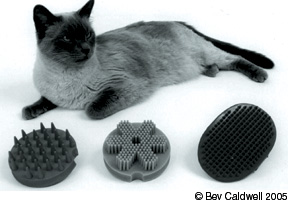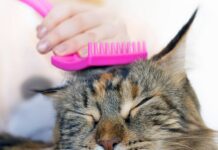Whether your cat has fluffy long hair, shiny short hair or practically no hair, its fur requires fastidious care. Your pet spends 10 to 30 percent of its waking hours keeping itself beautiful. Besides its aesthetic qualities, fur provides clues to your cats health.

252
Most domestic cats have two coats. A soft, thick undercoat called secondary hair grows in clusters from single follicles and provides warmth. Short, bristly awn hairs and soft, wavy down hairs make up this layer. Above these are stiff, longer hairs called primary or guard hairs. These hairs grow individually from single follicles and give your pets coat its color and pattern. Scattered throughout Kittys coat are larger-sized individual hairs, called tylotrichs, that behave like whiskers and detect sensory information.
Keeping Kitty Cool
Your cat starts grooming its own fur weeks after birth to regulate body temperature. Keeping the hair clean, dry and untangled improves the insulating effect of fur. Wet, dirty or matted hair coats may actually cause heat loss, explains Dr. Paul DeMars, DVM of Oklahoma State University, who is board certified by the American Board of Veterinary Practitioners. As winter approaches, your feline realigns the hairs in its coat with its tongue so that they retain heat and block out cold. And in summer, grooming can keep a cat cool; the evaporation of the saliva deposited on Kittys coat can reduce body heat by one third.
Shedding Season
Cats may shed in response to both temperature and genetics, but most shedding is triggered by increased sunlight. In the winter months, the undercoat fills in to provide more insulation. In the light-filled months of summer, many cats shed these extra undercoat hairs. Exposure to artificial light, however, interferes with the growth-and-shedding cycle, so indoor cats tend to shed year-round, as do longhaired cats in general. In any cat, excessive shedding can indicate a health problem.
Cats also use their coats to deter enemies. Piloerection, or hair standing on end, makes the cat appear bigger than it is. This is offensive if directed at another cat, or defensive if directed, say, against a potential predator, explains Dr. DeMars. Cats will erect the hair along the spine and tail, forming a ridge for a more impressive look.
Kittys coat color originally evolved as camouflage. With the development of the domestic cat, coat patterns became more varied. Today a cats coat is valued more for its beauty than for its masking ability.
If your pets coat becomes dull, faded or dry in appearance, something is wrong. A host of physical maladies can affect the coat, so any changes should prompt a visit to your vet.
Some people have linked coat color to temperament. Red and tortoiseshell cats have been tagged as quicker to react to stress while black cats are said to be more tolerant. Many white cats (especially those with blue eyes) tend to be deaf.

288
Bald Spots
Abnormal hair loss (alopecia) caused by excessive licking or tugs from kittys teeth signals a problem. Pulling of fur can indicate fleas, mange, ringworm and other illnesses.
Although most cats that groom excessively probably have itchy skin, a few seem to mow their fur compulsively in the absence of any detectable physical abnormality.
Some cats have a self-mutilation behavioral problem that we dont fully understand, says Dr. DeMars. If your kitty has a balding problem, see your vet immediately.
You can help maintain your pets coat and reduce the incidence of hairballs by brushing it regularly. Dr. DeMars advises paying special attention to overweight cats, as they may have trouble reaching certain areas and may need more assistance. And if you have a longhaired cat, clipping the hair near the anus will help keep the area clean.
A byproduct of brushing is bonding, so start the process early. Consistent and gentle brushing can become a very enjoyable experience for your cat. Brushing also promotes circulation, stimulates the skin, and affords an opportunity for you to check for any body changes (tumors, rashes, fleas) that may require a visit to your vet.
There is rarely a need to give your cat a bath, since she naturally cleans herself. However, if your cat comes home excessively dirty, a bath with a pet shampoo or a brisk rubbing with a damp towel may be in order.



